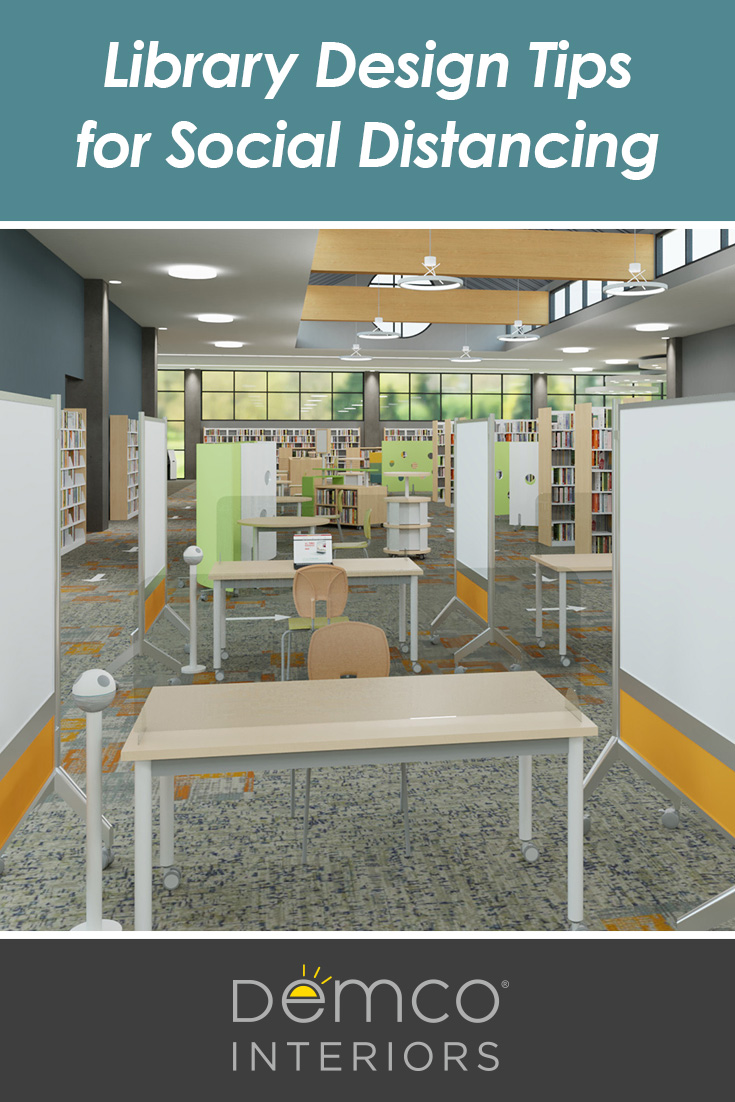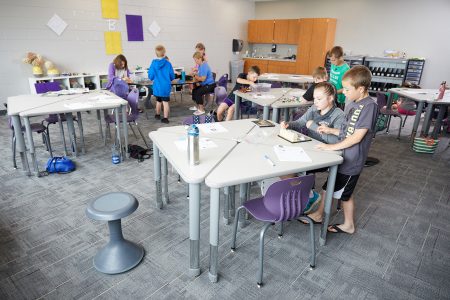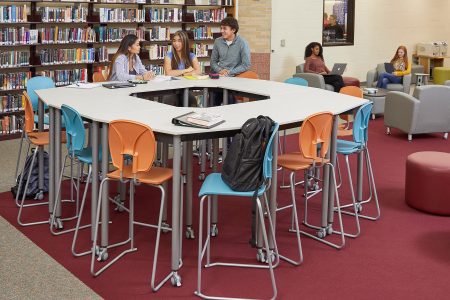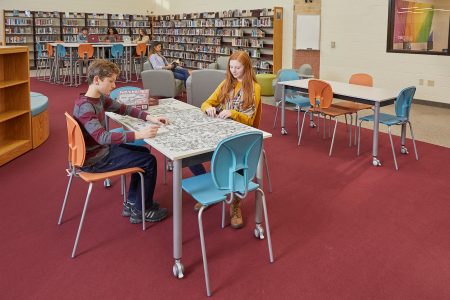 If you’re like many librarians, you’ve spent years making your library as inviting as possible — a place for your community to learn, connect, and recharge. Now, the COVID-19 pandemic has changed everything. You need to adapt your library design for a very different future. Do you have to start all over?
If you’re like many librarians, you’ve spent years making your library as inviting as possible — a place for your community to learn, connect, and recharge. Now, the COVID-19 pandemic has changed everything. You need to adapt your library design for a very different future. Do you have to start all over?
Actually, no. There are things you can do right away, with minimal investment, to ensure your environment is safe and welcoming in a post-pandemic world. Read below for sensible design solutions to help keep your patrons and staff safe.
Start Your Library Design Plans with Spacing
Grab a tape measure and take a walk around your library floor. Can patrons easily pass through stacks and seating areas while maintaining six feet of separation? Are there pinch points where visitors can’t help but bump into each other?
At least in the short term, you might want to consider moving or removing some bookshelves to open up tight spaces. Ask yourself the following questions:
- Are there underutilized areas you can expand shelving into or areas such as community rooms you can use that won’t be needed in the near future?
- Can you spend time weeding or store less-circulated materials for now to open up your floor space?
- Do you have mobile shelving that can be easily reconfigured or used to create barriers or pathways?
Consider the placement of the rest of your furniture. Start by separating mobile tables and moving lounge furniture apart to create more distance between patrons. Can you find ways to rearrange to create smaller personal spaces? One way to create additional workspaces is to remove some chairs and place acrylic barriers across tables to separate patrons.
Then, take a look at your computer stations. Can you implement acrylic barriers between them or move computers to smaller tables in other areas to create more space? If your computer stations are currently set up in rows, consider moving them apart with personal carrels or spacing them out on work surfaces placed around the perimeter of the room.
Review Your Traffic Flow
 Next you should examine your traffic flow. Delineate one-way aisles to help patrons avoid each other in spaces that do not allow for six feet of social distancing. Put up freestanding signage, and mark the route on the floor with arrow floor clings. Keep in mind that habits can be hard to break, so at first, staff may have to remind patrons to follow the directional signage when entering an aisle or to wait a few minutes if they can’t safely share the space with others.
Next you should examine your traffic flow. Delineate one-way aisles to help patrons avoid each other in spaces that do not allow for six feet of social distancing. Put up freestanding signage, and mark the route on the floor with arrow floor clings. Keep in mind that habits can be hard to break, so at first, staff may have to remind patrons to follow the directional signage when entering an aisle or to wait a few minutes if they can’t safely share the space with others.
If you have longer aisles in your library, consider removing a central 36-inch-wide section from any existing tall shelving. This will give patrons an additional ADA-accessible exit point within aisles where passing safely may be a challenge. Also, you may want to swap out tall shelving for low-level units where you can. They usually have shorter aisle lengths, which helps break up long stretches of materials. If you can invest in some additional shelving units, consider mobile options to give you flexibility into the future.
If your library already has some mobile shelving, you’ll find it really useful now as you reconfigure your space. Move it as needed to create, define, and clarify one-way traffic routes. Since mobile shelving is typically lower in height than static shelving, patrons will have a line of sight through the aisle that allows them to determine whether an aisle is clear of other library users before entering that space.
You can also use mobile barriers such as whiteboards or traffic barriers to further define traffic routes.
Reroute Patrons at Your Circulation Desk
 In busy libraries, the area around the circulation desk tends to be the most crowded with patrons and staff. Floor decals will help you encourage safe distancing. Stick them six feet apart to separate visitors waiting to check out materials. Add health shields with pass-through windows to circulation desks to help protect staff and patrons as they interact with each other. You may also need to adjust book return locations to correlate with one-way traffic flow routes and allow for easy quarantining. (For more tips on how to quarantine books, read “How to Quarantine Public Library Materials.”)
In busy libraries, the area around the circulation desk tends to be the most crowded with patrons and staff. Floor decals will help you encourage safe distancing. Stick them six feet apart to separate visitors waiting to check out materials. Add health shields with pass-through windows to circulation desks to help protect staff and patrons as they interact with each other. You may also need to adjust book return locations to correlate with one-way traffic flow routes and allow for easy quarantining. (For more tips on how to quarantine books, read “How to Quarantine Public Library Materials.”)
Learn How to Design Your Library for a Post-COVID-19 World
Download this guide to discover how you can promote safety while still creating a welcoming library environment. Learn how to choose the right furnishings, and get design solutions that make patrons feel safe while still enabling you to provide essential services.
By placing sanitization stations at the entrance and exit, as well as at the entrance to the line for your service desk, you can provide patrons with a convenient opportunity to disinfect their hands. Encouraging them to do this before entering the library helps keep surfaces within the building cleaner.
Encourage patrons to use touch-free self-checkout stations whenever possible. This will help reduce the issue of multiple patrons needing to touch the same surface throughout the day. Even so, provide disinfectant wipes alongside your checkout stations, and ask patrons to wipe them down after use.
Help Patrons Work Smart and Safe
 Even before COVID-19, you might have been thinking about ways to create more quiet, semi-private workspaces for your patrons. If possible, take advantage of perimeter walls and move workstations out to low-traffic locations. These areas usually have good access to power, allow for single-user dynamics, and position users away from the aisle.
Even before COVID-19, you might have been thinking about ways to create more quiet, semi-private workspaces for your patrons. If possible, take advantage of perimeter walls and move workstations out to low-traffic locations. These areas usually have good access to power, allow for single-user dynamics, and position users away from the aisle.
Do you already have small mobile tables? Combine them with mobile screens to create attractive, well-spaced nooks. Use mobile whiteboards or screens that have laminate or coated fabric surfaces to make them easier to wipe down and keep clean. For existing large tables, consider adding vertical barriers between them or placing acrylic barriers directly on the table to establish a defined and enclosed space for each user.
Providing access to power in multiple places will allow patrons to choose spaces farther apart from each other and not to congregate around power outlets.
Mind the Children
 It’s not always easy to keep kids contained in “their” areas. Do what you can to create appealing micro-spaces for your youngest patrons — preferably out of the way of major traffic areas. Mid-height laminate screens and furniture with coated fabrics or vinyl surfaces are easy to clean, colorful, and durable. Single-faced shelving can create a natural screen. With a mobile option, you can reconfigure your spaces to support social distancing while maintaining a playful and fun environment for children to be in. Combine the shelving with ColorScape Playpods, which are designed to provide cozy, personal spaces for reading.
It’s not always easy to keep kids contained in “their” areas. Do what you can to create appealing micro-spaces for your youngest patrons — preferably out of the way of major traffic areas. Mid-height laminate screens and furniture with coated fabrics or vinyl surfaces are easy to clean, colorful, and durable. Single-faced shelving can create a natural screen. With a mobile option, you can reconfigure your spaces to support social distancing while maintaining a playful and fun environment for children to be in. Combine the shelving with ColorScape Playpods, which are designed to provide cozy, personal spaces for reading.
 For older kids, high-back seating helps define contemporary teen spaces while also keeping them separated. Pull-up side tables can support digital devices and reduce the need for static computer stations, and active stool seating created from molded plastic can be easily sanitized. Mobile screening with integrated desktops and high tables placed against perimeter walls offer an engaging personal space to do research or other homework. Place decals along the tables to show patrons where to sit to ensure proper distancing.
For older kids, high-back seating helps define contemporary teen spaces while also keeping them separated. Pull-up side tables can support digital devices and reduce the need for static computer stations, and active stool seating created from molded plastic can be easily sanitized. Mobile screening with integrated desktops and high tables placed against perimeter walls offer an engaging personal space to do research or other homework. Place decals along the tables to show patrons where to sit to ensure proper distancing.
Continue Re-evaluating
The global pandemic has brought unprecedented changes to the way we live, work, and interact with one another, but in this new world, libraries still have an essential role to play. With planning and continued re-evaluation, your library can take on these challenges, and you’ll be ready to welcome your patrons back with confidence. To learn more about how to safely reopen your library, read “Public Libraries: Your Guide to Reopening.”
Experience a Public Library Designed for Social Distancing
These 360° views of public library spaces will help you visualize how to set up your library to keep staff and patrons safe.
Stephen Gower
Stephen leads Demco’s Design Services team. He is an experienced furniture, product and interior designer with a background in designing educational products and impactful educational interiors. Stephen has 20 years of design experience, including 5 years of international experience at Demco Interiors UK in England.
Stephen holds a Bachelor of Arts, with honors, in Furniture Design from Brunel University in High Wycombe, England. His awards include the 2017 EDspaces Classroom Design Winner, awarded for “unique spaces designed by leading architects and designers in the field and outfitted with the latest innovations that make learning spaces come to life.”
Latest posts by Stephen Gower (see all)
- Library Design Tips for Social Distancing - May 28, 2020
- How Biophilic Learning Environments Boost Student Achievement - October 14, 2019
- Checklist: Designing Engaging Library Spaces for Children - October 19, 2018
- Top 5 Learning Environment Design Trends - September 21, 2018
- 5 Tips for Planning Early Literacy Library Spaces - August 1, 2018







